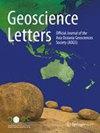The crustal deformation mechanism of southern Chuandian block: constrained by S wave velocity and its azimuthal anisotropy
IF 4.3
3区 地球科学
Q1 GEOSCIENCES, MULTIDISCIPLINARY
引用次数: 0
Abstract
We construct the 3D Shear wave velocity and azimuthal anisotropy images in the southern Chuandian block using phase velocity dispersion of Rayleigh wave in the period of 5–45 s. The images show two extensive low-velocity zones with a depth range of 20–40 km. The west range of the low-velocity extends from the Lijiang-Xiaojinhe fault to the Red River fault, while its east range follows along the Xiaojiang fault. Two ranges of low velocities are merged at the southern inner belt of the Emeishan Large Igneous Provinces (ELIP). The observed fast directions of azimuthal anisotropy are consistent with the extension of low-velocity ranges at the lower crust. The findings reveal the presence of two potential weak channels in the lower crust, characterized by low-velocity zones, which align with the hypothesis of lower crustal flow. Meanwhile, the crust around the inner belt of ELIP exhibits a high-velocity body characterized by a northeast-trending and counter-clockwise azimuthal anisotropy. Combined with geological data, we attribute the high S-velocity to a mafic–ultramafic magma reservoir of the ELIP, which blocks the continuity of crustal flow within the southern Chuandian block, thus dividing the lower crustal flow into two branches. Additionally, we also find the fast directions of azimuthal anisotropy above 20 km align well with the strike-slip fault orientations. The above research results indicate that the crustal deformation in the southern Chuandian block is likely attributed to the joint action of the two deformation mechanisms. One involves a lower crustal flow model, while the other entails rigid extrusion controlled by the deep-seated, large-scale strike-slip faults in the upper crust.南川店地块地壳变形机制:S波速度及其方位各向异性的约束
利用瑞利波5-45秒的相位速度频散,构建了川地块南部的三维剪切波速度和方位各向异性图像。西部低速带从丽江-小金河断层延伸至红河断层,东部低速带则沿小金河断层延伸。两条低速带在峨眉山大火成岩带南部内带汇合。观测到的快速方位各向异性方向与低速范围在地壳下部的延伸一致。研究结果表明,下地壳存在两个潜在的弱通道,其特征是低速区,这与下地壳流动的假说一致。同时,ELIP内带周围的地壳呈现出一个高速体,其特征是呈东北走向和逆时针方位各向异性。结合地质资料,我们将高S向速度归因于ELIP的黑云母-超黑云母岩浆储层,它阻断了南川地块内地壳流动的连续性,从而将下地壳流动分为两支。此外,我们还发现20千米以上方位各向异性的快速方向与走向滑动断层的走向十分吻合。上述研究结果表明,南川地块的地壳变形很可能是两种变形机制共同作用的结果。一种是下地壳流动模式,另一种是上地壳深层大尺度走向滑动断层控制的刚性挤压。
本文章由计算机程序翻译,如有差异,请以英文原文为准。
求助全文
约1分钟内获得全文
求助全文
来源期刊

Geoscience Letters
Earth and Planetary Sciences-General Earth and Planetary Sciences
CiteScore
4.90
自引率
2.50%
发文量
42
审稿时长
25 weeks
期刊介绍:
Geoscience Letters is the official journal of the Asia Oceania Geosciences Society, and a fully open access journal published under the SpringerOpen brand. The journal publishes original, innovative and timely research letter articles and concise reviews on studies of the Earth and its environment, the planetary and space sciences. Contributions reflect the eight scientific sections of the AOGS: Atmospheric Sciences, Biogeosciences, Hydrological Sciences, Interdisciplinary Geosciences, Ocean Sciences, Planetary Sciences, Solar and Terrestrial Sciences, and Solid Earth Sciences. Geoscience Letters focuses on cutting-edge fundamental and applied research in the broad field of the geosciences, including the applications of geoscience research to societal problems. This journal is Open Access, providing rapid electronic publication of high-quality, peer-reviewed scientific contributions.
 求助内容:
求助内容: 应助结果提醒方式:
应助结果提醒方式:


